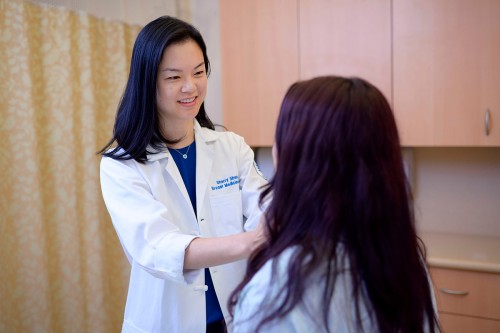Larry Norton Explains the Development of Dose-Dense Chemotherapy and His Hopes for the Future
Even at the dawn of the chemotherapy era in the 1940s and ‘50s, doctors and scientists were already thinking about how to improve this revolutionary cancer treatment. At the time, many experts believed that in order to kill more cancer cells, they had to give a patient more chemotherapy.
But dose-dense chemotherapy, which calls for less time between doses compared with a standard treatment plan, gave this more-is-more theory a new context. MSK medical oncologist Larry Norton pioneered the technique in the 1970s for the treatment of people with breast cancer.
Though the story of dose-dense chemotherapy began 40 years ago, a new analysis presented at the San Antonio Breast Cancer Symposium provides even more proof that the strategy is effective and safe for patients with breast cancer. University of Oxford researcher Richard Gray presented the data.
Dr. Norton, who is Deputy Physician-in-Chief for Breast Cancer Programs and Medical Director of MSK’s Evelyn H. Lauder Breast Center, says these results represent the culmination of part of his life’s work. To learn more about dose-dense chemotherapy and the purpose of this new analysis, we spoke with Dr. Norton in advance of the conference.
What is dose-dense chemotherapy?
In the 1970s, there was a lot of attention in the cancer community about how high the dose of chemotherapy could be pushed. We knew there would be more side effects for patients, but there would also be more benefit.
Dose-dense chemotherapy pushes treatments closer together in time and allows for greater benefit for patients, with no increase in side effects.
Compared with a standard plan, dose-dense chemotherapy controls cancer growth more effectively, improves overall survival for patients, and does not add any long-term side effects.
How did we arrive at the conclusion that dose-dense chemotherapy works?
This work started in 1977 when my colleague Richard Simon and I started analyzing data from animal studies of breast cancer. We applied mathematics and came up with a model to understand the way cancers grow and respond to therapy. This work gave us the hypothesis behind dose-dense chemotherapy, but we had to figure out how to push doses closer together.
We learned that we couldn’t reduce the chemotherapy dose below a certain level or else it wouldn’t have an effect. If you administered the correct dose level, it would suppress the bone marrow for three weeks. In our model, though, we learned that ten to 14 days was the best window to administer a second dose. So we needed to find a way to shorten that bone marrow recovery time from three weeks to ten to 14 days. In the 1980s, MSK oncologist Malcolm Moore and his colleagues developed a drug called filgrastim, also known as G-CSF or Neupogen, to accelerate the recovery of bone marrow.
As filgrastim was being tested and developed, I came on board at MSK to test my idea of dose-dense therapy. I joined Clifford Hudis and Andrew Seidman at MSK as well as Marc Citron from Northwell Health — we all wanted to test this idea. In 1997, we started a clinical trial in people with breast cancer. Now, in 2017, we are seeing an analysis of a collection of worldwide studies involving thousands of patients treated this way.
Forty years after our mathematical model and 20 years after our trial started, we can see that our initial predictions came true.
Can dose-dense chemotherapy be applied to other types of cancer?
My hope is that it will be. There is some application of dose-dense chemotherapy outside of breast cancer, including in lymphomas and ovarian cancer. We took a systematic approach in breast cancer, and I’d like to see that expand to other cancers.
I also hope this motivates scientists to study why the math works. The concept was not just based on breast cancer — this applies to cancer across the board. An even better understanding of the mathematics and the biology will allow us to continue to develop more-effective and less-toxic treatments.
What does the future of breast cancer chemotherapy look like?
Right now, I think we are maxed out in terms of benefit we can get with chemotherapies that are available. I think we now need to try to apply our ideas to targeted therapies and precision medicines, which are based on an individual patient’s biology. We proved the idea of dose-dense therapy with chemotherapy, but now we need to apply it to even-more-effective cancer treatments.
What is particularly exciting about the release of these results?
It’s profoundly exciting and gratifying to think about this discovery and to think about all the people that were involved along the way.
This was a group activity from the very beginning. A lot of the preliminary work was done here in the Breast Medicine Service at MSK under Dr. Hudis. That work was brought to the Cancer and Leukemia Group B, which is a group funded by the federal government, and they did the definitive testing. This final analysis was done by the Oxford Overview, which is made of clinical researchers from all over the world.
Very often we think about hero scientists working alone in their laboratory making major discoveries to change the world. That’s not the way science has ever been done, really, and it’s certainly not the way science is done now.
And of course, the patients. None of this would have been possible without our brave patients — more than 30,000 of them in total — who dedicated so much to help advance cancer care.






